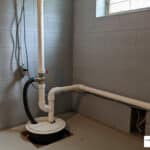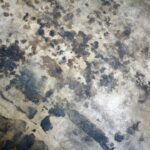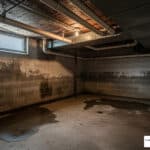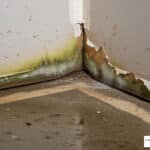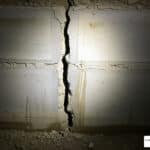Protecting Your Home’s Foundation from the Outside In
An exterior foundation moisture barrier is a protective membrane or coating applied to the outside of your foundation walls. Its job is simple but critical: stop water from ever reaching your basement or crawl space. These systems create a waterproof shield between your home and the wet soil, directing water away before it can cause mold, mildew, or serious structural damage.
Here in Maryland and Pennsylvania, our clay-heavy soils and unpredictable weather make foundation moisture a constant battle. In fact, nearly 98% of basements will have a moisture problem at some point. An exterior barrier is your first and best line of defense. It stops water before it gets in, while interior systems are designed to manage water that has already penetrated your walls. Think of it like this: an umbrella keeps you dry from the start, while a raincoat deals with rain that’s already hitting you.
I’m Amber Pirog, CEO of Oriole Basement Waterproofing. For over two decades, I’ve helped homeowners across our community protect their foundations. Our engineering-backed approach ensures your exterior foundation moisture barrier not only stops water today but continues protecting your home for decades to come.
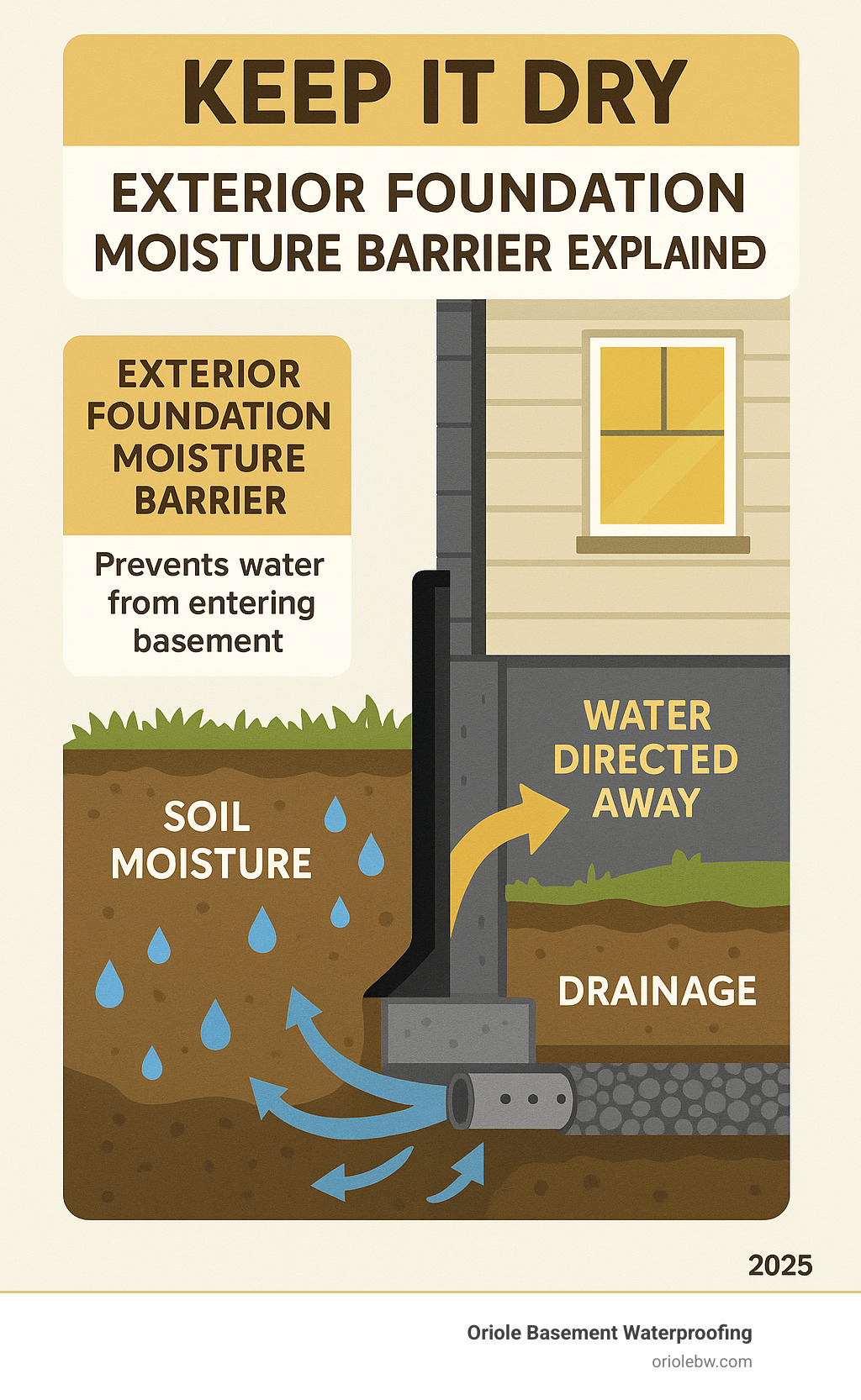
Your Guide to a Strong and Dry Exterior Foundation Moisture Barrier
When you’re dealing with Maryland’s weather or Pennsylvania’s heavy rains, understanding how an exterior foundation moisture barrier works is essential. After seven decades in this business, I’ve seen what happens when this crucial protection is skipped. The good news is, once you know the basics, you can make an informed choice for your home.
The Main Types of Exterior Moisture Barriers
Think of an exterior foundation moisture barrier as your home’s raincoat. Different situations call for different types of protection. Here’s what we typically use for homes in our Maryland and Pennsylvania service areas.
- Liquid-applied membranes are like painting a waterproof shield directly onto your foundation. We spray or roll these thick coatings on to form a seamless, flexible barrier that’s perfect for foundations with lots of angles, like we often see in older Baltimore City rowhomes.
- Sheet membranes are tough, pre-made rolls of rubberized asphalt or high-density polyethylene. We carefully apply them to foundation walls with generous overlaps to ensure a continuous, waterproof seal.
- Dimple boards are a smart choice for many local homes. These textured plastic sheets create a small air gap between the board and your foundation. This space lets the wall breathe while directing water down to a drainage system. They are incredibly durable and can bridge typical wall cracks with ease.
- Cementitious coatings are cement-based mixtures that create a rigid, waterproof coating. They bond directly to concrete or block foundations and work especially well for the older masonry we see throughout Harford County and Lancaster County.
All these systems work on the same principle: they stop water before it can reach your porous foundation walls. Concrete acts like a sponge, and these barriers create an impermeable shield to keep it dry.
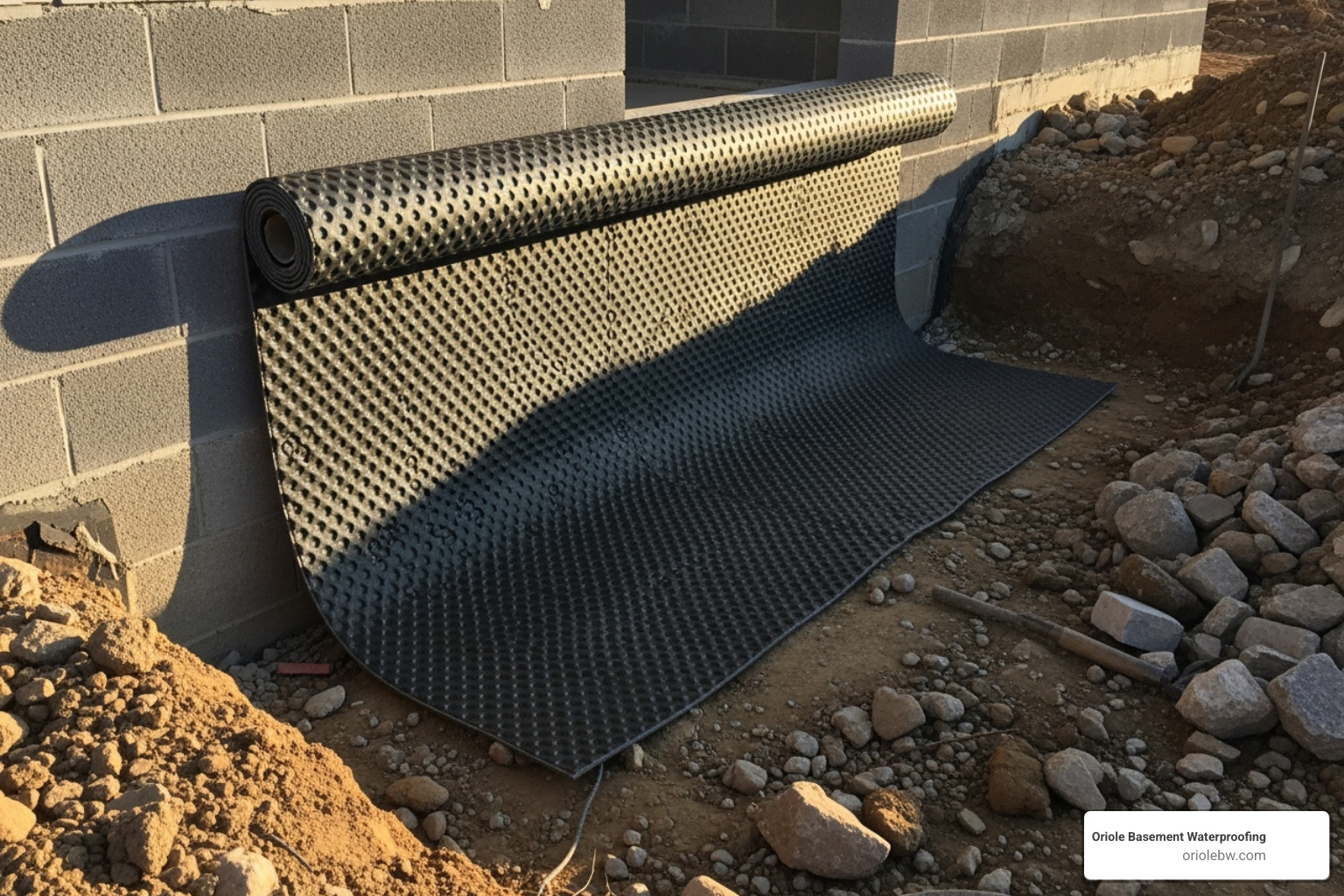
Damp-Proofing vs. Waterproofing: A Critical Distinction
Understanding this difference has saved countless homeowners from expensive mistakes. “Damp-proofing” and “waterproofing” are two completely different levels of protection.
Damp-proofing is a thin, asphalt-based coating designed to resist soil dampness when there’s no water pressure. It’s like a light jacket on a misty day. It can’t handle the force of water building up in the soil, known as hydrostatic pressure.
Waterproofing is the heavy-duty solution that prevents water from passing through even under hydrostatic pressure. This is the force water exerts after heavy rains in places like Anne Arundel County and York County. A true waterproofing system, like a thick membrane combined with proper drainage, is designed to resist this pressure.
Why does this matter? A cheap fix that only damp-proofs your foundation will fail when a real storm hits. I’ve seen it happen time and again across Howard County. True positive-side waterproofing, applied to the exterior, is the most successful approach because the water pressure actually helps push the membrane tighter against the wall.
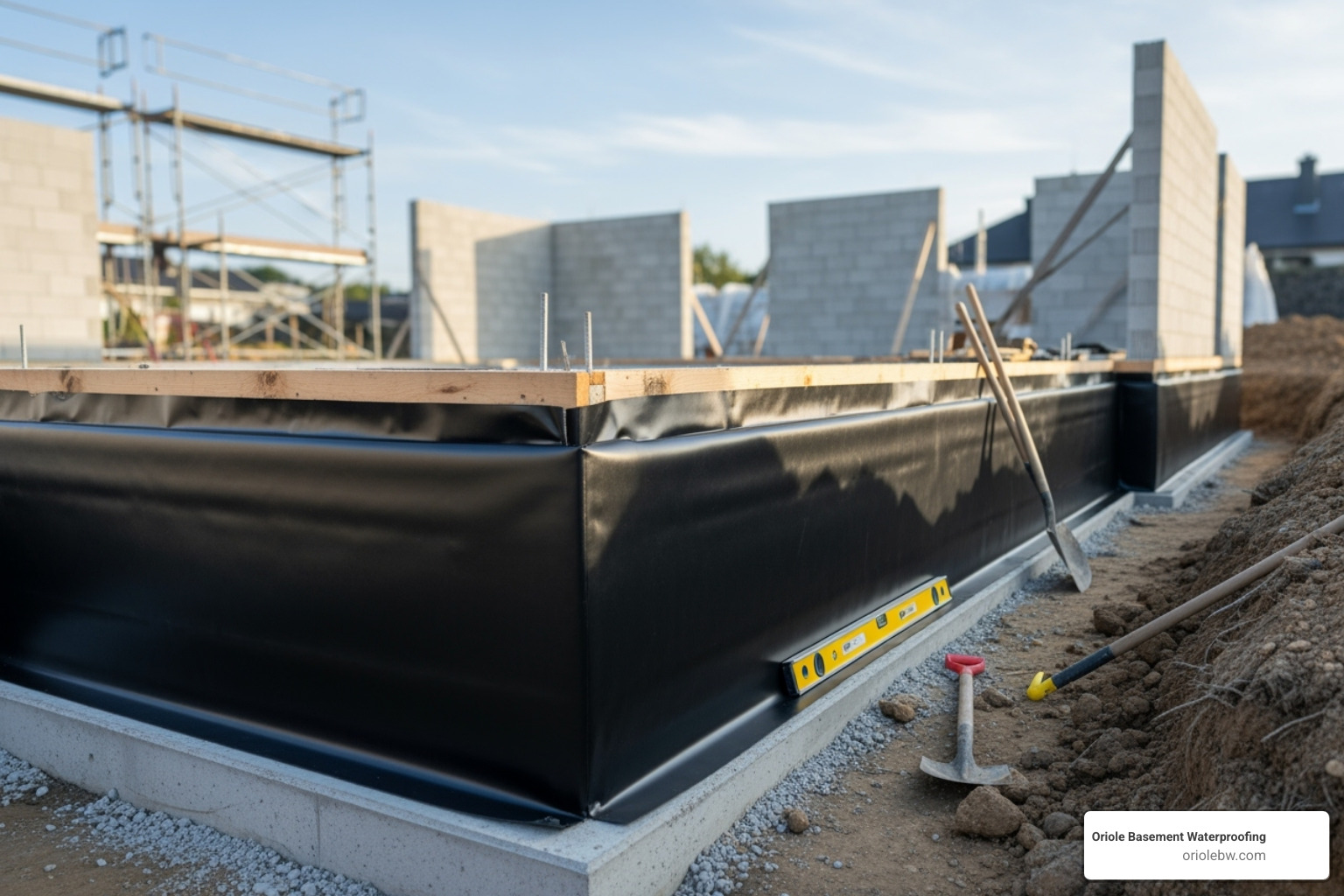
Why Professional Installation is Non-Negotiable
Installing an exterior foundation moisture barrier is a major construction project, not a weekend DIY task. It involves serious risks and requires expertise to get right. Here’s a look at the complexities our professional crews handle.
- Excavation & Safety: This is the most intensive part. We dig a deep trench around your foundation, down to the footing. This is dangerous work that requires following strict safety protocols to prevent trench collapse and avoid hitting buried utility lines.
- Foundation Prep & Repair: This is the most critical step. We carefully clean the exposed walls to ensure the new barrier will adhere properly. This is also when we identify and repair any structural issues. With the foundation exposed, we can fix cracks, repoint failing mortar on older block or stone foundations, replace damaged sill plates, and even install carbon fiber straps to stabilize bowing walls. A foundation must be sound before it can be waterproofed.
- Barrier & Drainage Integration: Applying the membrane is a precise job, but the barrier is only half the system. We also install a drainage system, often called a French drain, at the base of the footing. A properly installed French drain is key to collecting water and channeling it away from your foundation, relieving the pressure that causes leaks.
- Careful Backfilling & Grading: The final steps are just as important. We carefully backfill the trench to avoid damaging the new barrier. Then, we grade the soil to ensure surface water slopes away from your house, not toward it. These details are essential for a long-lasting solution.
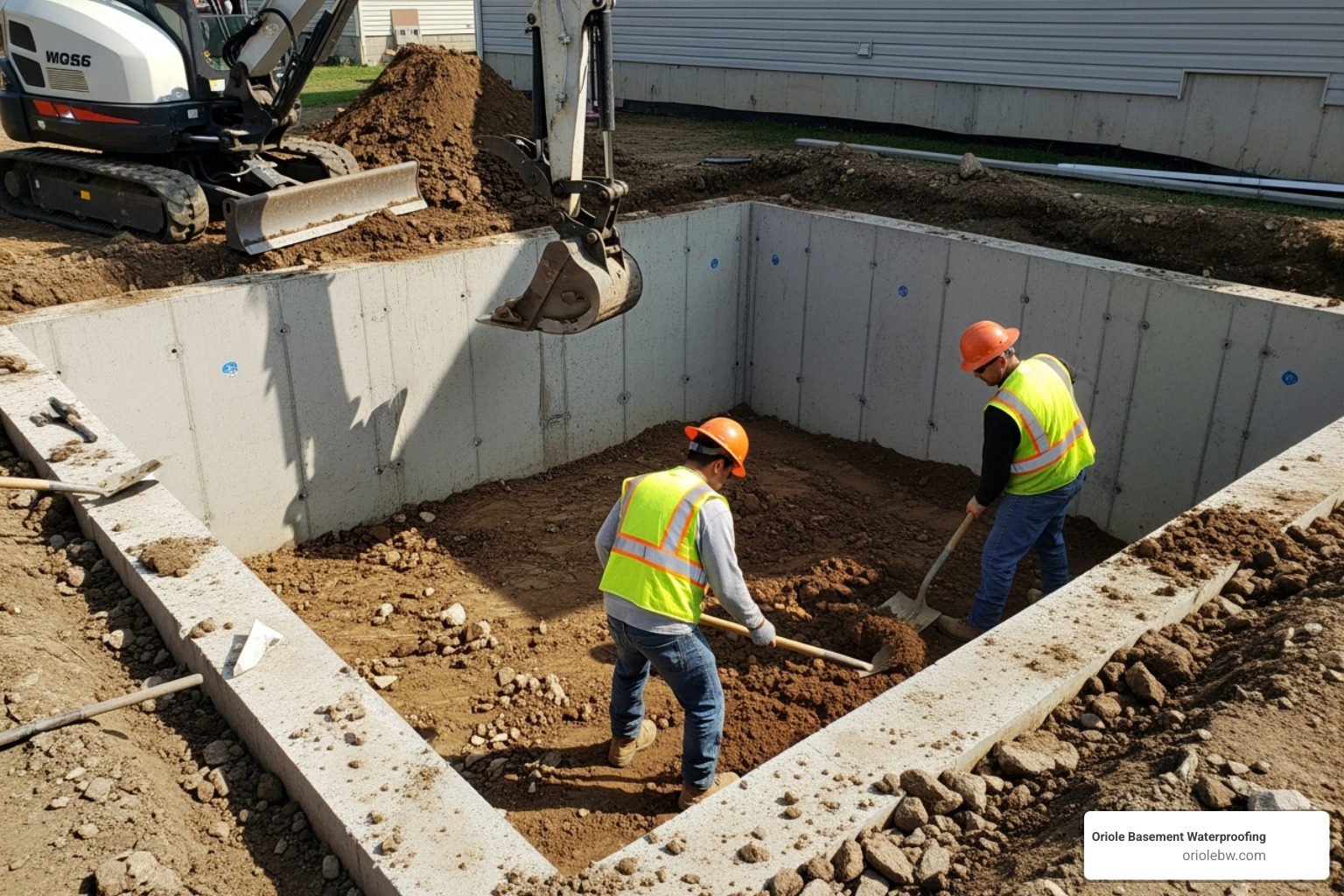
Special Considerations for Different Foundation Types
After 70+ years working on homes across Maryland and Pennsylvania, we know that a one-size-fits-all approach doesn’t work. The right exterior foundation moisture barrier depends on your foundation type.
- Poured Concrete: Common in newer homes, these foundations are strong but can still crack. Liquid-applied or sheet membranes are excellent choices because they create a seamless seal over the entire surface.
- Concrete Block: These foundations, common in Baltimore County and Harford County, are more porous and have many mortar joints where water can enter. We often recommend robust dimpled membranes or high-quality cementitious coatings combined with a strong drainage system.
- Fieldstone Foundations: Found in historic areas like Gettysburg and older parts of Baltimore, these beautiful foundations require special care. The irregular stone surfaces and old mortar joints create many potential leak points. For these, we often use flexible, liquid-applied membranes that conform to the uneven surface after carefully repointing the mortar. It takes an experienced hand to waterproof these homes correctly, which is why homeowners trust our decades of expertise.
Maintaining Your Barrier and Knowing When to Call for Help
An exterior foundation moisture barrier is a smart investment in your home, but it’s important to know the signs of trouble so you can protect that investment. The good news? Most of the maintenance is just paying attention to what your house is telling you.
Signs of Failure and When to Inspect Your Exterior Foundation Moisture Barrier
A professionally installed waterproofing membrane should last for many years, but nothing is forever. A typical system can last 10 to 20 years, but it’s wise to be vigilant, especially after heavy storms or our region’s harsh freeze-thaw cycles. Your basement will give you clues when something is wrong.
- A musty smell: That damp, earthy odor is often the first sign that moisture has found a way inside.
- Efflorescence: This is a white, chalky powder that appears on concrete or block walls. It’s a deposit of mineral salts left behind as water seeps through the wall and evaporates, showing you exactly where moisture has been.
- Damp walls: If your basement walls feel cold and clammy, or you see dark, wet patches, water is getting past your barrier.
- Peeling paint or wallpaper: In a finished basement, moisture trapped behind the walls will eventually cause paint and wallpaper to bubble and peel.
- Visible water: This is the most obvious sign. If you see puddles on the floor or water trickling down the walls after it rains, your barrier is no longer doing its job.
If you notice any of these signs, don’t wait. A small issue can become a major, expensive problem if ignored. And remember, if you see mold growth with active water intrusion, we can solve the source of the problem. For mold issues without a current leak, we can connect you with our trusted partners at Raven Mold for remediation. A reliable drainage system is also key, which includes having a plan for power outages. Our guide to sump pump battery backups can help keep your system running no matter the weather.

The Value of a Professional Solution
We understand that a complete exterior foundation moisture barrier system, which can range from $5,000 to $15,000, is a significant investment. It can be tempting to consider a DIY approach, but after seven decades of fixing failed attempts, we know some jobs are too important to risk.
The excavation alone is dangerous. Digging a trench 6-8 feet deep around your home risks hitting utility lines and trench collapse. The surface preparation is another critical point of failure for DIY projects. If the wall isn’t perfectly cleaned and prepped, even the best materials won’t stick, rendering the entire project useless.
Here’s what your investment with a professional team gets you: safe excavation, professional-grade materials, expert preparation and installation, an integrated drainage system, and most importantly, accountability. Our 70+ years of experience means we’ve handled every foundation challenge imaginable, from the fieldstone in historic Gettysburg to the concrete block basements in Anne Arundel County.
Every solution we provide is engineering-backed, and we stand behind our work with a lifetime transferable guarantee on foundation repairs and encapsulation. When you hire Oriole, you’re not just buying a moisture barrier. You’re investing in a permanent solution, peace of mind, and the long-term health and value of your home.
Ready to protect your biggest investment? Get a free inspection for your home and let our team show you exactly what your foundation needs to stay strong and dry for decades to come.

